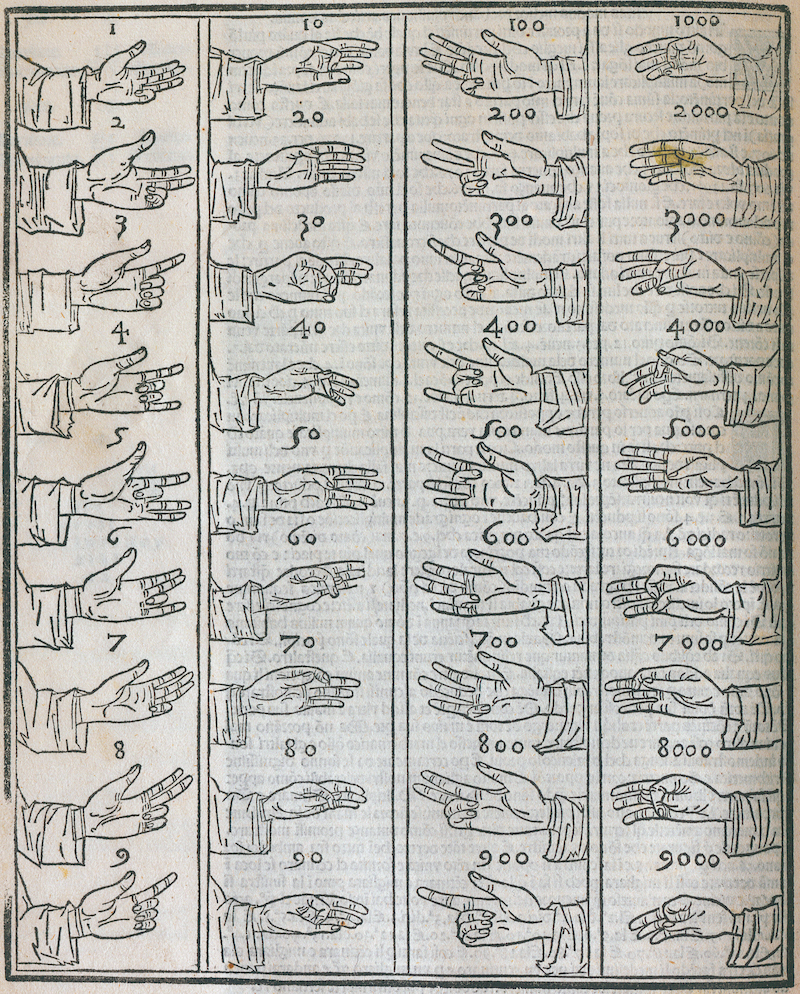A Brief History of English Numeracy
The people of late medieval and early modern England were almost universally numerate. Is our ability to count the thing that makes us human?

The English medical practitioner John Bulwer wrote a treatise in 1644 that argued humans were natural ‘Arithmeticians’, capable of both performing arithmetic and divining the underlying laws that govern mathematics. This innate ability with numbers was not an accident, he argued, but rather an integral part of God’s plan for humanity: ‘That divine Philosopher doth draw the line of man’s understanding from this computing faculty of his soul, affirming that therefore he excels all creatures in wisdom, because he can account.’ According to this view, numeracy – a person’s knowledge of and ability to work with numbers – derived from the human soul and was the foundation of humankind’s dominion over the world. The Christian God made humans to be universally numerate, with the exception only of ‘idiots and half-souled men’, who lacked some essential quality inherent in the rest of humanity.
The people of late medieval and early modern England were, in fact, almost universally numerate; judges used the inability to perform basic mathematical tasks such as counting up 20 pence as a standard to prove mental incompetency. Anecdotal evidence demonstrates that, since children were raised in a numerate culture, they naturally learned to associate number words with quantities and began to add small quantities using mental, verbal or finger-based arithmetic strategies without much, if any, formal school instruction. Finger-counting, in particular, was seen as the reason the English number words have a base of ten. As Bulwer explained, God gave humans ten fingers as part of his numerical plan for humanity and the cosmos: fingers were ‘those numbers that were born with us and cast up in our Hand from our mother’s womb, by Him who made all things in number, weight & measure’.
Beyond this point, however, numeracy could vary dramatically as people used a variety of different object-based and written symbols for numbers in their day-to-day lives. Many object-based systems were idiosyncratic, created to meet the needs of an individual urban shopkeeper or rural farmer, but two of these systems were widely used by the English population and government: tally sticks and counting boards. The former involved a wooden stick, notched to indicate quantities, then split in half to record a credit-and-debt transaction. The latter was a system used for performing arithmetical operations and was particularly useful for its ability to simultaneously calculate with the mixed base-ten, base-12, and base-20 English currency. These served the needs of both the literate and illiterate, but those who could write also had the ability to use the three written symbolic systems: written number words (one, two, three), the ancient Roman numerals (i, ii, iii) and the relatively new and increasingly popular Arabic numerals (1, 2, 3).

By the 16th and 17th centuries literacy rates were on the rise in England and new printing presses made it easier and faster to produce books for the increasingly literate population. This included books introducing Arabic numeral arithmetic, which as a written system of arithmetic was better suited to being taught through printed textbooks than the older, object-based system of counting boards. Textbooks were also a relatively affordable way to acquire arithmetical knowledge: a new textbook could be had for between two and four shillings in the 17th century and used textbooks might be as cheap as sixpence. These textbooks could be used alone or as a supplement to in-person tutoring and were often passed down through a family’s children into the next generation. While Arabic numerals were less flexible than individual, idiosyncratic systems, commercial pressures incentivised elites and the middling sort to acquire this increasingly popular written form of numeracy.
At the turn of the 18th century Arabic numerals and arithmetic were fast on their way to becoming the dominant symbolic system and the new standard for judging a person’s ability with numbers. In 1701 Scottish polymath John Arbuthnot equated this narrowed form of numeracy with civilisation itself and declared it would ruin the economy ‘were the easy practice of [Arabic numeral] Arithmetick abolished [and] Merchants and Tradesmen oblig’d to make use of no other than the Roman way of notation by Letters’. However, despite the increasing pressure for people to abandon older forms of numeracy, object-based symbols continued to be used by the illiterate. Even those who had adopted Arabic numerals would use other forms of numeracy when they were more convenient, traditional, or served some other non-mathematical purpose. In a shining example of government inertia, the Exchequer only decided to phase out tally sticks in 1783 but delayed implementation until the sinecure holders who profited from them had retired, which did not come until 1826. The attempt to burn the now-obsolete tally sticks accidentally burned down Parliament in 1834.
Modern numeracy has changed significantly from late medieval and early modern numeracy, but there are still echoes of the past. Today it is assessed by a person’s knowledge of Arabic-numeral based mathematics, but these symbols have not completely eliminated older forms of numeracy. People still use spoken and written number words, children learn to count with the assistance of their fingers, and the current king is Charles III not Charles 3. The minimum standard for an acceptable knowledge of numbers has increased to include what were once advanced topics, but we still assume a universal basic numeracy. No one can easily navigate the English-speaking world without understanding the numbers that make up addresses, phone numbers, the time of day and day of the month. And while it is cognitive scientists – rather than preachers and divines – who assure us that numeracy is an inborn part of the human mind, the inherent belief that humans are natural arithmeticians remains.
Jessica Marie Otis is Assistant Professor of History at George Mason University and author of By the Numbers (Oxford University Press, 2024).






